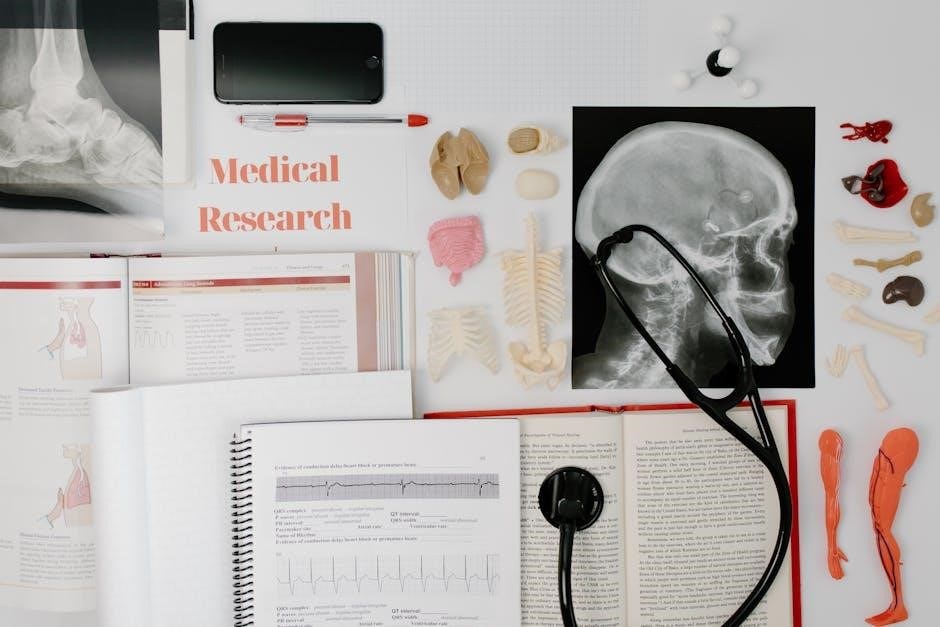Employers use basic math tests to assess problem-solving skills, ensuring candidates can handle numerical tasks relevant to their roles. These tests evaluate attention to detail and cognitive abilities, helping employers identify strong candidates efficiently.
The Purpose of Math Tests in Job Applications
Math tests in job applications are designed to evaluate a candidate’s ability to apply numerical skills to real-world problems. Employers use these assessments to ensure applicants can perform tasks requiring basic arithmetic, algebra, and problem-solving. By measuring cognitive abilities, math tests help employers identify individuals who can handle job-specific calculations accurately and efficiently. These tests often mimic workplace scenarios, such as budgeting, measuring quantities, or interpreting data. They also assess attention to detail and the ability to work under time constraints. For roles like accounting, engineering, or retail, strong math skills are crucial, making these tests a reliable tool for screening candidates. Additionally, math tests help reduce errors in daily operations by ensuring employees can manage numerical tasks effectively. This makes math assessments a vital part of many hiring processes, especially in industries where precision is essential.
Importance of Basic Math Skills in the Workplace
Basic math skills are essential for problem-solving, data interpretation, and decision-making in most jobs. They enable employees to perform tasks like budgeting, measuring materials, and calculating timelines accurately. Strong math abilities also reflect logical thinking and attention to detail, which are critical for efficiency and reducing errors. Employers value these skills as they contribute to overall workplace productivity and reliability. Additionally, math proficiency fosters confidence in handling financial and operational responsibilities, making employees more versatile and adaptable in their roles. In industries like retail, healthcare, and engineering, even basic arithmetic is fundamental for tasks such as inventory management, medication dosing, and project planning. Thus, assessing math skills through employment tests helps employers identify candidates who can meet job demands effectively.

Structure of a Basic Math Test for Employment
A basic math test typically includes arithmetic, algebra, and word problems, timed to assess problem-solving speed and accuracy. The format varies but often features multiple-choice or open-response questions.
Types of Questions Included in the Test
Basic math tests for employment typically include a variety of question types to assess numerical proficiency. These often involve arithmetic operations, such as addition, subtraction, multiplication, and division, applied to both simple and complex problems. Algebraic expressions and equations are also common, requiring candidates to solve for unknown variables. Geometry questions may ask for calculations involving shapes, areas, and volumes. Word problems are frequently included to evaluate problem-solving skills in real-world contexts, such as calculating costs, discounts, or budgets. Additionally, tests may incorporate data interpretation questions, where candidates analyze charts or tables to extract and apply numerical information. Multiple-choice and open-response formats are often used to accommodate different testing styles. The questions are designed to reflect practical workplace scenarios, ensuring relevance to the job role. This variety ensures a comprehensive evaluation of a candidate’s mathematical abilities and problem-solving skills.
Difficulty Levels of Math Problems
Basic math tests for employment typically feature problems ranging from simple arithmetic to more complex calculations. The difficulty levels are designed to assess a candidate’s ability to handle numerical tasks relevant to the job. At the basic level, questions may involve addition, subtraction, multiplication, and division of whole numbers. Intermediate problems might include decimals, percentages, and basic algebra, such as solving simple equations. Advanced questions could cover ratios, proportions, and word problems that require practical application of math skills. Employers often tailor the difficulty to the role, ensuring the test reflects the math skills needed for the position. This progression helps employers evaluate a candidate’s problem-solving abilities and attention to detail, which are critical for many jobs. By varying the difficulty, tests can accurately measure a candidate’s readiness for the responsibilities of the role.
Time Limits and Test Format
Basic math tests for employment typically have strict time limits, ranging from 30 to 60 minutes, depending on the employer and the test’s complexity. The format often includes multiple-choice questions, open-response problems, or interactive tasks. Some tests may incorporate practical tools like calculators or spreadsheets to simulate real-world scenarios. The time constraint is designed to assess a candidate’s ability to work efficiently under pressure, a crucial skill in many roles. Employers may also vary the format to align with specific job requirements, ensuring the test reflects the numerical demands of the position. This approach helps employers evaluate not only mathematical accuracy but also problem-solving speed and adaptability.
Common Topics Covered in the Test
Basic math tests for employment often cover essential topics like arithmetic operations, algebra, geometry, and word problems. These assessments typically include questions on basic numeracy, fractions, decimals, percentages, and ratios. Algebraic expressions, simple equations, and graph interpretation may also be included. Geometry problems might involve calculating areas, volumes, and perimeters of common shapes. Word problems simulate real-world scenarios, testing the ability to apply math to practical situations. Data interpretation questions, such as reading charts and graphs, are common as well. The tests aim to evaluate a candidate’s ability to perform calculations accurately and think critically. By focusing on these core areas, employers ensure that candidates possess the foundational math skills necessary for the role. This structure helps employers assess problem-solving abilities and attention to detail effectively.

Preparing for a Basic Math Employment Test
Preparation is key to succeeding in basic math employment tests. Review core concepts, practice with sample tests, and use online resources to improve accuracy and speed.
Tips for Effective Test Preparation
To excel in a basic math test for employment, effective preparation is crucial. Start by identifying common test topics, such as arithmetic, algebra, and word problems, and focus your practice on these areas. Regularly solving sample questions helps familiarize yourself with the test format and timing. Use online resources or practice books to simulate real test conditions, ensuring you complete tasks within the allocated time. Additionally, review basic math concepts and formulas to build a strong foundation. Practicing mental math and using flashcards can improve speed and accuracy. Analyze your mistakes to avoid repeating them and seek feedback to refine your skills. Staying calm and managing test anxiety through relaxation techniques will also enhance your performance. Consistent practice and a well-organized study plan are key to achieving success in employment math tests.
Recommended Resources for Practice
Several resources are available to help prepare for basic math employment tests. Online platforms like Khan Academy and Coursera offer free courses and practice exercises. Websites such as Quizlet provide flashcards and interactive tests. Additionally, PDF guides like “Basic Math Test for Employment with Answers” are widely available, offering structured practice with solutions. Employers often share sample tests or study materials specific to their industry. Mobile apps like Photomath and Mathway can also assist with problem-solving strategies. Practicing with these tools ensures familiarity with test formats and improves confidence. Regular review of basic arithmetic, algebra, and data interpretation is essential for success. Leveraging these resources can significantly enhance test performance and readiness for real-world applications.
Importance of Practicing with Sample Tests
Practicing with sample tests is crucial for success in basic math employment exams. It helps candidates familiarize themselves with the test format, question types, and time constraints. By solving sample questions, individuals can identify weak areas and focus their study efforts effectively. Regular practice builds confidence and reduces test anxiety, allowing candidates to perform at their best. Additionally, sample tests provide real-world examples of problems encountered in workplace scenarios, enhancing problem-solving skills. Reviewing answers and explanations from sample tests enables learners to understand common mistakes and improve their strategies. Employers often use these tests to assess practical skills, making practice essential for demonstrating readiness for job responsibilities. Consistent practice ensures a strong foundation in basic math, which is vital for many roles. Ultimately, sample tests are a valuable tool for achieving success in employment math assessments.
Strategies to Manage Test Anxiety
Managing test anxiety is crucial for performing well in basic math employment tests. Deep breathing exercises can help calm nerves, while positive visualization can boost confidence. Practicing sample tests allows candidates to familiarize themselves with the format, reducing uncertainty. Time management is key; allocate time wisely to avoid rushing. Understanding the test structure beforehand can also ease anxiety. Skipping difficult questions initially and returning to them later can prevent panic. Staying hydrated, getting adequate sleep, and maintaining a healthy diet are essential for mental clarity. Employers often provide clear instructions, so reading carefully is vital. Remember, anxiety is natural, but preparation and mindset can help mitigate its impact. Reviewing mistakes from practice tests can also build confidence and improve problem-solving skills.

Sample Questions from Basic Math Tests
Questions often include arithmetic operations, algebraic expressions, and word problems. Examples: calculating discounts, solving equations, or interpreting data. Answers are provided to help candidates assess their problem-solving skills effectively.
Arithmetic Operations and Examples
Arithmetic operations form the foundation of basic math tests for employment, focusing on addition, subtraction, multiplication, and division. These questions assess a candidate’s ability to perform calculations accurately and efficiently. Examples include solving problems like 12.50 + 7.30 = ? or 48 ÷ 6 = ?. Such questions are designed to evaluate a candidate’s grasp of fundamental math skills, which are essential for roles involving calculations, budgeting, or financial tasks. Practice materials, such as “basic math test for employment with answers PDF,” often include these types of problems to help candidates improve their speed and accuracy. By mastering these operations, job seekers can demonstrate their readiness to handle numerical challenges in the workplace. Regular practice with sample tests ensures confidence and proficiency in these core math skills.
Algebraic Expressions and Equations
Algebraic expressions and equations are commonly included in basic math tests for employment to assess a candidate’s ability to solve problems systematically. These questions may involve simplifying expressions, solving for variables, or interpreting algebraic relationships. For example, a test might ask to solve for ( x ) in the equation ( 2x + 5 = 11 ) or simplify an expression like ( 3(4y ─ 2) ). Employers use these questions to evaluate critical thinking and problem-solving skills, which are essential in many roles. Practice with sample tests can help improve both speed and accuracy. Understanding algebraic concepts is particularly important for jobs involving budgeting, inventory management, or technical tasks. By mastering these skills, candidates demonstrate their ability to handle real-world challenges efficiently. Regular practice with algebraic problems ensures better performance in employment-related math assessments.
Geometry and Measurement Problems
Geometry and measurement problems in basic math tests assess spatial reasoning and the ability to calculate lengths, areas, and volumes. Questions often involve shapes like triangles, rectangles, and circles, requiring the use of formulas such as the Pythagorean theorem or the area of a circle (πr²). Measurement problems may ask for conversions between units, such as inches to feet or liters to gallons. These questions simulate real-world scenarios, like calculating materials needed for construction or measuring liquid volumes in manufacturing. Accurate calculations and understanding of geometric principles are essential for roles in engineering, architecture, or trades. Practice with sample problems can help build confidence and speed in solving these types of questions. Employers use these tests to ensure candidates have practical math skills applicable to their specific industry.
Word Problems and Real-World Applications
Word problems and real-world applications are essential components of basic math tests for employment, as they simulate practical workplace scenarios. These questions require candidates to interpret and solve mathematical problems within contextual situations, such as budgeting, calculating distances, or adjusting recipes. For example, a question might ask about allocating resources or determining the cost of materials for a project; These problems assess critical thinking and the ability to apply mathematical concepts to everyday challenges. Employers use these questions to evaluate how well candidates can translate numerical skills into actionable solutions, ensuring they are prepared for job-specific tasks. By focusing on practical applications, these problems help employers identify individuals who can effectively handle real-world responsibilities. This approach ensures that math skills are not just theoretical but directly relevant to the workplace, making hiring decisions more informed and accurate.
Data Interpretation and Basic Statistics
Data interpretation and basic statistics questions assess your ability to analyze and draw conclusions from numerical information. These questions often involve understanding charts, graphs, and tables to calculate averages, percentages, or trends. Employers value this skill as it reflects your ability to make informed decisions in real-world scenarios. Common topics include interpreting bar graphs, calculating median and mode, and understanding basic probability concepts. You may also be asked to identify patterns or predict outcomes based on data. Practice with sample datasets and statistical tools can improve your speed and accuracy. Mastering these skills demonstrates your capability to handle data-driven tasks effectively in the workplace.

Answer Keys and Explanations
Answer keys provide correct solutions, enabling candidates to review and understand their mistakes. Detailed explanations clarify problem-solving methods, helping improve math skills and prepare effectively for future tests.
How to Review and Learn from Answers
Reviewing and learning from answers is crucial for improving math test performance. Start by comparing your responses to the correct answers, identifying mistakes, and understanding the right methods. Analyze each error to grasp where you went wrong, whether it was a calculation mistake or a misunderstanding of the concept. Focus on the reasoning behind each solution to strengthen problem-solving skills. Practice similar problems to reinforce learning and build confidence. Use resources like basic math test answer PDFs to access explanations and examples, helping you master tricky concepts. Regularly reviewing your progress ensures long-term improvement. Additionally, seek feedback or tutoring if persistent challenges arise. By systematically reviewing answers, you can pinpoint weaknesses, refine your approach, and excel in future tests. This process not only enhances math proficiency but also boosts overall test-taking strategies and confidence. Consistent practice and review are key to success in employment math tests.
Common Mistakes to Avoid
When taking a basic math test for employment, candidates often make avoidable errors that can negatively impact their results. Rushing through problems without reading them carefully is a frequent mistake, leading to incorrect interpretations of questions. Another common error is miscalculating simple arithmetic operations due to nervousness or lack of practice. Many test-takers also struggle with time management, spending too much time on one question and running out of time for others. Additionally, some individuals overlook basic concepts like order of operations or unit conversions, which can lead to incorrect answers. To avoid these pitfalls, it’s essential to practice regularly, stay calm during the test, and allocate time evenly across all questions. Reviewing answers, if time permits, can also help catch mistakes before submitting the test.

Employer Perspectives on Math Tests
Employers value math tests to assess problem-solving skills and cognitive abilities, ensuring candidates can handle job-specific numerical tasks. These tests help compile fair, comparable data for informed hiring decisions.
Why Employers Use Math Tests for Hiring
Employers utilize basic math tests to evaluate a candidate’s problem-solving abilities and numerical literacy, which are critical for many roles. These assessments help ensure that applicants possess the foundational skills needed to perform job-specific tasks efficiently. By measuring attention to detail and cognitive abilities, employers can identify individuals who are likely to excel in their positions. Additionally, math tests provide a standardized method for comparing candidates, ensuring fairness in the hiring process. They also allow employers to gauge a candidate’s ability to work under time constraints and handle pressure, which are valuable traits in a workplace setting. Ultimately, these tests help employers make informed decisions about who is best suited for the role and capable of contributing effectively to the team. This approach aligns with the practical demands of the job, ensuring a strong match between the candidate’s skills and the position’s requirements.
Success Stories from Job Applicants
Many job applicants have successfully advanced their careers by excelling in basic math tests. For instance, a candidate secured a position at Outlier after performing well on their math assessment, demonstrating problem-solving skills. Others have shared how practicing with PDF guides improved their confidence and accuracy, leading to better job opportunities. These success stories highlight the impact of strong math skills in securing employment and career growth.
Employers often report that candidates who excel in math tests are more likely to thrive in roles requiring numerical proficiency. These assessments not only evaluate skills but also reveal a candidate’s ability to apply knowledge in real-world scenarios, making them valuable tools for hiring decisions.

Mastering basic math tests is crucial for job success, enhancing problem-solving skills and confidence. Regular practice and review of answers improve accuracy and speed, ensuring readiness for employment opportunities.
Summarizing Key Takeaways
Basic math tests for employment are essential for assessing a candidate’s ability to apply numerical skills in real-world scenarios. These tests evaluate problem-solving, attention to detail, and cognitive abilities, helping employers identify qualified candidates. Practicing with sample tests and resources, such as PDF guides, is crucial for improving accuracy and time management. Understanding common question types, like arithmetic operations and word problems, enhances preparation. Employers value these tests as they reflect a candidate’s readiness to handle job-specific tasks efficiently. By focusing on key areas and avoiding common mistakes, candidates can significantly improve their performance. Ultimately, excelling in math tests demonstrates a strong foundation in essential skills, increasing confidence and competitiveness in the job market.

Motivation to Excel in Math Tests
Motivation is key to excelling in basic math tests for employment. Understanding the relevance of these tests in securing a job can drive candidates to prepare diligently. Success stories, like landing a high-paying role at Outlier, highlight the rewards of mastering math skills. Practicing with sample tests and resources, such as those found in “basic math test for employment with answers pdf,” builds confidence and problem-solving abilities. Setting goals, like improving speed and accuracy, keeps candidates focused. The ability to represent problems in multiple ways, as noted in studies, enhances understanding and performance. Overcoming test anxiety through strategies like deep breathing and positive visualization further boosts readiness. Ultimately, excelling in math tests not only secures employment but also fosters personal growth and a stronger foundation in critical thinking.
- Set clear goals for improvement.
- Use practice tests to build confidence.
- Stay positive and manage anxiety.